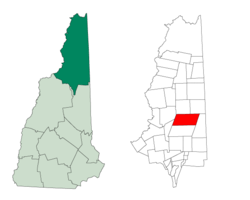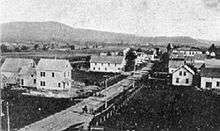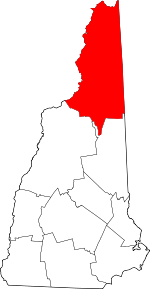Milan, New Hampshire
Milan (/ˈmaɪlən/ MY-lən) is a town in Coos County, New Hampshire, United States. The population was 1,337 at the 2010 census.[1] It is part of the Berlin, NH–VT Micropolitan Statistical Area. It was named for the city of Milan in Italy.
Milan, New Hampshire | |
|---|---|
Town | |
First United Methodist Church in Milan | |
 Location in Coos County, New Hampshire | |
| Coordinates: 44°34′24″N 71°11′06″W | |
| Country | United States |
| State | New Hampshire |
| County | Coos |
| Incorporated | 1824 |
| Villages | Milan West Milan |
| Government | |
| • Board of Selectmen | Randy Fortin, Chair Peter Nolet Kenneth Lee Dube |
| Area | |
| • Total | 64.6 sq mi (167.2 km2) |
| • Land | 63.8 sq mi (165.2 km2) |
| • Water | 0.8 sq mi (2.0 km2) 1.17% |
| Elevation | 1,135 ft (346 m) |
| Population (2010) | |
| • Total | 1,337 |
| • Density | 21/sq mi (8.0/km2) |
| Time zone | UTC-5 (Eastern) |
| • Summer (DST) | UTC-4 (Eastern) |
| ZIP code | 03588 |
| Area code(s) | 603 |
| FIPS code | 33-47860 |
| GNIS feature ID | 0873665 |
| Website | www |
History

Originally named Paulsburg in 1771 after Paul Wentworth, the town was incorporated on December 16, 1824. In that year, Governor Levi Woodbury authorized a name change to Milan, in honor of Milan Harris.
Prior to 1820 there were but few inhabitants. In 1819 the population was about fourteen; ten years passed and the number had increased four-fold. Like the other towns around it, Milan's first industries were lumbering operations, and agriculture was for some time subordinate to this. The firms farms were developed on Milan hill. The soil was warmer, more free from frost, and, for some years, produced quite liberally in response to the labors of the pioneers. But they were not permanently as productive as they gave promise, and many of those settlers who remained south the most valuable lands along the river. Some of the names of the early pioneers of Milan include Ellingwood, Hodgdon, Fogg, Hinds, Roberts, Hagar, Sargent, Nay, Twitchell, and Newell.
Geography
According to the United States Census Bureau, the town has a total area of 64.6 square miles (167 km2), of which 63.8 square miles (165 km2) is land and 0.8 square miles (2.1 km2), or 1.17%, is water.[2] The highest point is the summit of Deer Ridge, at 2,808 feet (856 m) above sea level.
The town of Milan is bordered by Berlin to the south, Kilkenny and Stark to the west, Success to the east, and Dummer and Cambridge to the north.
Demographics
| Historical population | |||
|---|---|---|---|
| Census | Pop. | %± | |
| 1830 | 243 | — | |
| 1840 | 386 | 58.8% | |
| 1850 | 493 | 27.7% | |
| 1860 | 789 | 60.0% | |
| 1870 | 710 | −10.0% | |
| 1880 | 895 | 26.1% | |
| 1890 | 1,029 | 15.0% | |
| 1900 | 1,135 | 10.3% | |
| 1910 | 924 | −18.6% | |
| 1920 | 730 | −21.0% | |
| 1930 | 719 | −1.5% | |
| 1940 | 782 | 8.8% | |
| 1950 | 743 | −5.0% | |
| 1960 | 661 | −11.0% | |
| 1970 | 713 | 7.9% | |
| 1980 | 1,013 | 42.1% | |
| 1990 | 1,295 | 27.8% | |
| 2000 | 1,331 | 2.8% | |
| 2010 | 1,337 | 0.5% | |
| Est. 2017 | 1,235 | [3] | −7.6% |
| U.S. Decennial Census[4] | |||
As of the census[5] of 2000, there were 1,331 people, 532 households, and 388 families residing in the town. The population density was 21.6 people per square mile (8.3/km2). There were 756 housing units at an average density of 12.2 per square mile (4.7/km2). The racial makeup of the town was 98.95% White, 0.08% African American, 0.30% Native American, 0.08% Asian, 0.23% from other races, and 0.38% from two or more races.
There were 532 households, out of which 31.8% had children under the age of 18 living with them, 62.4% were married couples living together, 5.5% had a female householder with no husband present, and 26.9% were non-families. 21.4% of all households were made up of individuals, and 7.9% had someone living alone who was 65 years of age or older. The average household size was 2.50 and the average family size was 2.92.
In the town, the population was spread out, with 25.8% under the age of 18, 3.7% from 18 to 24, 29.8% from 25 to 44, 28.5% from 45 to 64, and 12.3% who were 65 years of age or older. The median age was 41 years. For every 100 females, there were 105.1 males. For every 100 females age 18 and over, there were 107.1 males.
The median income for a household in the town was $40,966, and the median income for a family was $47,361. Males had a median income of $32,500 versus $20,670 for females. The per capita income for the town was $19,818. About 3.0% of families and 5.7% of the population were below the poverty line, including 7.0% of those under age 18 and 13.8% of those age 65 or over.
Sites of interest
References
- United States Census Bureau, American FactFinder, 2010 Census figures. Retrieved March 23, 2011.
- "Geographic Identifiers: 2010 Demographic Profile Data (G001) - Milan town, New Hampshire". United States Census Bureau. Retrieved November 8, 2011.
- "Annual Estimates of the Resident Population: April 1, 2010 to July 1, 2017 (PEPANNRES): Minor Civil Divisions – New Hampshire". Archived from the original on February 13, 2020. Retrieved November 14, 2018.
- "Census of Population and Housing". Census.gov. Retrieved June 4, 2016.
- "U.S. Census website". United States Census Bureau. Retrieved 2008-01-31.
